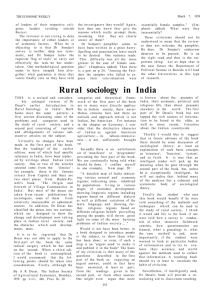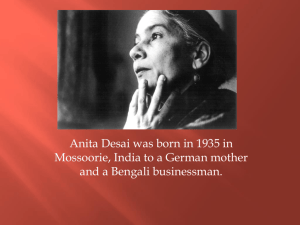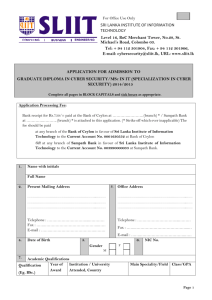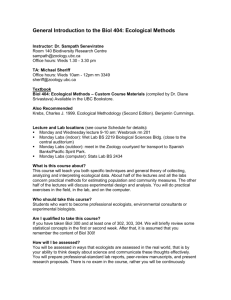The fringes of society are rich with the impressions left... individuals, who inhabit a reality that operates on principles vastly... The Art of Invisibility in Kiran Desai’s Hullabaloo in the...
advertisement
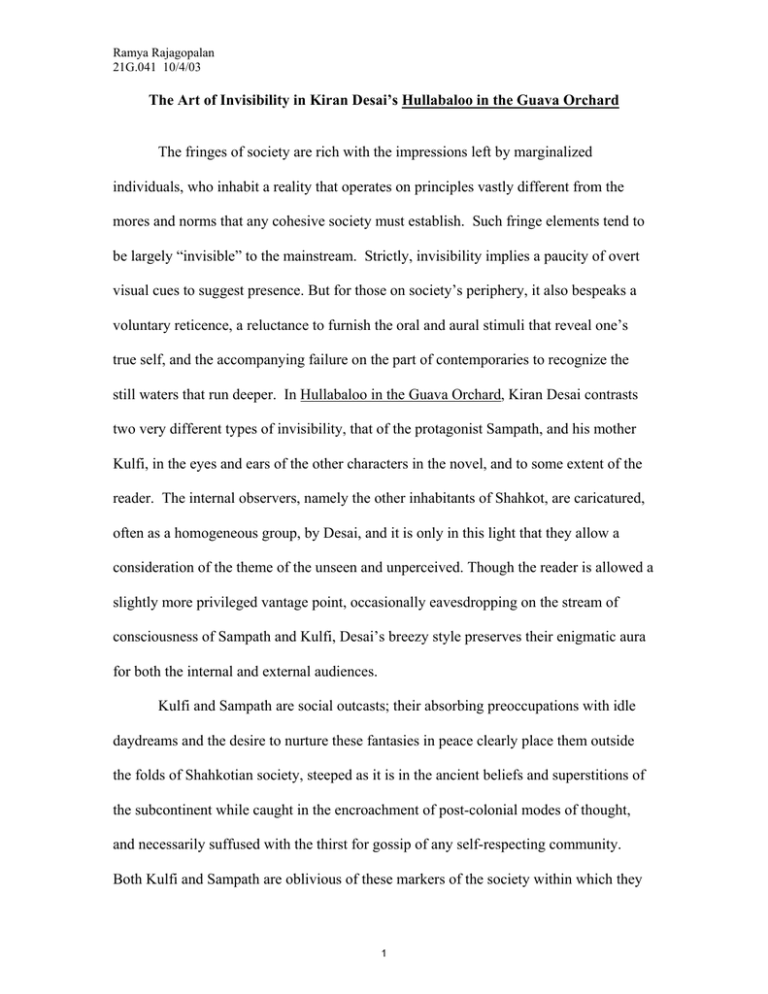
Ramya Rajagopalan 21*.041 10/4/03 The Art of Invisibility in Kiran Desai’s Hullabaloo in the Guava Orchard The fringes of society are rich with the impressions left by marginalized individuals, who inhabit a reality that operates on principles vastly different from the mores and norms that any cohesive society must establish. Such fringe elements tend to be largely “invisible” to the mainstream. Strictly, invisibility implies a paucity of overt visual cues to suggest presence. But for those on society’s periphery, it also bespeaks a voluntary reticence, a reluctance to furnish the oral and aural stimuli that reveal one’s true self, and the accompanying failure on the part of contemporaries to recognize the still waters that run deeper. In Hullabaloo in the Guava Orchard, Kiran Desai contrasts two very different types of invisibility, that of the protagonist Sampath, and his mother Kulfi, in the eyes and ears of the other characters in the novel, and to some extent of the reader. The internal observers, namely the other inhabitants of Shahkot, are caricatured, often as a homogeneous group, by Desai, and it is only in this light that they allow a consideration of the theme of the unseen and unperceived. Though the reader is allowed a slightly more privileged vantage point, occasionally eavesdropping on the stream of consciousness of Sampath and Kulfi, Desai’s breezy style preserves their enigmatic aura for both the internal and external audiences. Kulfi and Sampath are social outcasts; their absorbing preoccupations with idle daydreams and the desire to nurture these fantasies in peace clearly place them outside the folds of Shahkotian society, steeped as it is in the ancient beliefs and superstitions of the subcontinent while caught in the encroachment of post-colonial modes of thought, and necessarily suffused with the thirst for gossip of any self-respecting community. Both Kulfi and Sampath are oblivious of these markers of the society within which they 1 Ramya Rajagopalan 21G.041 10/4/03 are physically embedded; they are in fact too wrapped up in their own thoughts, on an entirely different mental plane. This marginalization from the community, while largely self-imposed, also necessitates a kind of lone-star persona, one whose quest for silence contrasts sharply with the requisite din of town life. And living as they do outside the sphere of everyday life, their unique dialogue with reality, which constitutes for them a means of survival, becomes akin to artistic genius. Kulfi’s isolation from society is established at the outset; her blooming pregnancy is borne alone, in rooms cut off from the worried whispers of her husband and mother-inlaw. During her pregnancy, we are introduced to the eccentricity which surrounds her persona in the eyes of the townspeople: ’Oh dear, what is going to become of this woman?’ said Lakshmiji, the Raipurs, the Bengali teacher, and all of the others when they looked out of their windows, when they gossiped at the tea stall or sat in each other’s houses eating peanuts together. ‘There was always something odd about her,’ they said. (Desai, 5) In fact, by the time her son arrives, we get the sense that she has already diminished in importance to the main story line, hardly registering on the radar of her family, an invisible shadow flitting across the page. It is in this status of relegated secondary character that she appears to us and to her contemporaries, for the remainder of our encounter with her. Sampath, on the other hand, is ostensibly much more engaged with the people around him, even while he is likened to a “vegetable” (Desai, 26), a lazy dreamer lacking the common sense that would undoubtedly lift him up from the bottom rung of the social ladder. His innocent cross-dressing and stripping antics at the wedding reception solidify in the minds of both townspeople and reader the strangeness of his way of thinking. It is 2 Ramya Rajagopalan 21G.041 10/4/03 very telling that he is not at all ashamed of the scene he makes of himself, yet when he tries to conform to “normal” codes of conduct, echoing to his superior the crisp yet properly obsequious reply sternly advised by his father, he not only feels ridiculous but is self-conscious for the first and only time in the novel: …he chirped, ‘Yes, sir. I will see to it right now, sir.’ But once he began, the latter half of his sentence – the ‘right now, sir’ – amazed and shocked by the preceding words, grew shaky and trailed up thinly into the high ceiling of the room…They all turned to stare at him in surprise. Never had they heard him attempt such a sentence. It was most uncharacteristic. Realizing himself how odd he had sounded, his face burning, Sampath turned and scuttled off to his desk in the dark depths at the back of the post office. (Desai, 32-33) His efforts to sequester himself from the questions, the demands, the noise, of his family and the town are thwarted; in his own words he is “found out and turned away from every refuge” he seeks (Desai, 44). And then a guava explodes in his hands, and he is transformed: Sampath felt his body fill with a cool greenness, his heart swell with a mysterious wild sweetness. He felt an awake clear sap flowing through him, something quite unlike human blood…He could have sworn a strange force had entered him, that something new was circulating within him. (Desai, 46-47) At this point, Sampath becomes well and truly exiled beyond the reach of societal confines, both physical and those founded on expectations; his escape to the guava tree in the Orchard is merely a token enactment of his journey to a new state of mind. He has determined to seek and find freedom, far from the madding crowd. This freedom is, in one sense, a keen longing for spatial sequestration. In fact, from this point on, both Sampath and Kulfi hover on the fringes of the novel, above and below the din, respectively. Sampath has a definite association with the sky, and the heavens. It is in the midst of a prodigious raining of gifts from the skies that he enters the 3 Ramya Rajagopalan 21G.041 10/4/03 earthly realm, after all – both the monsoon torrents and the Red Cross relief package are harbingers of his birth. But in other ways his head is very much in the clouds, in a space between earth and the heavens that presses us with its yearning to be as skybound as possible. The irritating sleep-sounds of his family cause him to run to the roof; the clamor generated by their harping causes him to flee to the crown of a tree, overlooking the ensuing hullabaloo below. And at the end, he disappears as a guava over the crest of a high hilltop, borne by the monkeys: “Still the monkeys traveled. Higher and higher. Like a gust of wind that comes out of nowhere, rustles through the trees, and melts into nothing, like a ghost…the monkeys climbed on. Up into the wilderness, up to the shoulder of the highest mountain. Here the trees at the very summit wavered for a moment, bowed their heads as if in farewell – and then they were gone.” (Desai, 208-209) Kulfi is, in sharp contrast, very earthy. She is never the center of attention, like Sampath is, and partly because of this she seems to lurk below the plot, connected to the murmurings underfoot, of plants, animals, seasons. Ear and nose to the ground, on a treasure-hunt for the ingredients that bring to life her enchanting culinary concoctions, she represents ancient knowledge, and the lost art of sensing the world, rather than pedagogically apprehending it. Hers is the earth-mother role, guardian of its bounty, and her easy transition from a trapped muttering eccentric to a frenzied, driven, brilliant chef gives us the sense that she is heavy with the weight of a memory not her own but the accumulated wisdom of all human consciousness that has preceded her. Being outside of society initiates the exile of Sampath and Kulfi from the noise that defines it, and this in turn reflects their symbolic invisibility to the other characters. The disjunct between the textual space that Kulfi and Sampath occupy and that occupied by the townspeople in the novel is mirrored in the conflict that Desai poses between noise 4 Ramya Rajagopalan 21G.041 10/4/03 and silence. This tension permeates the novel, and she uses the marginalization and invisibility of both characters as a vehicle for its expression. Kulfi, in all ways more disconnected from the life of norms embodied by the town, is more extreme in her avidity for silence, though it is actually solitude that she seeks. For example, during her starved and difficult pregnancy, she turns not to her mother-in-law or her husband, but rather to the walls that cage her, drawing out her frustration, her dreams, making the bars of her prison serve the role of canvas. Yet she also welcomes the majestic and thunderous sounds of the storm that herald the imminent fruition of her painful gestation, suggesting that there may be an aural hierarchy, in which the sounds of nature do not intrude on silence and solitude, but those of human companionship do. Thus with Kulfi (and later with Sampath as well), Desai confounds the distinction between solitude and silence, silence being the necessary absence of verbal communication. This physical, oral and aural isolation is only heightened in the orchard, where Kulfi bustles about on her own terms, marching to her own drummer: “Here, in the orchard, the hold of other people on Kulfi and her awareness of them retreated even further and, like Sampath, she discovered the relief of space” (Desai, 78). She preferentially keeps to herself throughout the novel; even the reader rarely encounters any vocalized expression of her thoughts, and when they do appear, they are uncensored outpourings of her mind’s voice, and exclusively on the topic of alimentation. Sampath, on the other hand, shuns noise, but until the end he cannot manage to find and retain the silence he craves. Rather than the easy calm that Kulfi is able to carve out of her surroundings, we see Sampath unsuccessfully fleeing the sounds of society, which he finds demanding and invasive, slicing through him coldly like his father’s litany 5 Ramya Rajagopalan 21G.041 10/4/03 of verbal abuse. He, unlike Kulfi, is forced to make compromises to navigate the dichotomy of intrusive noise and exquisite silence; to find peace, he must first disturb it. Freedom is his ultimate goal, and that freedom constitutes a kind of anti-being, a stillness that is at one with nature and in harmony with the warm murmurs in its depths. But noise is the medium of communication for the rest of the world, those living on the inside of reality, for whom the airwaves must vibrate coherently. Thus it is that when Sampath-aswise-sage, in an act of desperation to secure peace and quiet, alters the frequencies of the airwaves with old homilies in a new context, the sonar of the townspeople kicks in, proclaims it as holy, and begs for more. And thus it is that while all Sampath craved in the Orchard was silence, he has found himself more noise then he ever bargained for, and in fact exacerbated the very din that he desperately tried to escape. Yet even when he is seemingly the center of attention, he is still fringe-bound, a novelty to be gawked at. He is drawn into the fold more than Kulfi, but it registers as a hollow façade even at the height of his popularity. Importantly, it is his very silence that ties Sampath’s hands, consigning him to sagehood, for, while desperation drives him to initiate the fateful recitation of forgotten secrets and maxims, he never once verbalizes his desire for the devotees to leave him alone. So in what may be the greatest irony in the novel, he is, in essence, still invisible as the revered Tree/Monkey Baba. Even as they flock to his feet, no one takes note of his silent pleas, for such a study would make it quite evident that what he really wants is to be left alone. In the Orchard, we see the isolation, the air of invisibility associated with Kulfi and Sampath, flower and bloom into what becomes a kind of artistic genius, like magic to the townspeople, yet their own means of survival. Both Kulfi and Sampath are, in a 6 Ramya Rajagopalan 21G.041 10/4/03 sense, traders in the commodity of the unseen. Kulfi buys her life’s purpose with the preparation of lavish meals exclusively for Sampath, made with ingredients hidden and mysterious to the rest of the world: “She cooked only for Sampath…for his was the only judgment Kulfi trusted. Almost all day she worked, trying this and that, producing, even in these early days of apprenticeship to her imagination, meals of such flavor and rarity that others could merely guess at what they were missing by the smells that rose from her pots…” (Desai, 79) Sampath’s fling with guruhood is founded, if desperately, on drawing the curtain on secret lives that are kept out of the public eye, buying him his stay in the Orchard. The mystique and curiosity these activities generate, by their unfamiliarity to the townspeople, naturally elevates them to an art form, the artistry taking on epic, even apocryphal, proportions. Both characters engage with their reality in highly artistic ways. Kulfi does so vibrantly, Sampath more weakly, as if his claim to artistry is genetically diluted. When Desai draws the curtains back so that the reader can peek into Sampath’s mind, we feel we are entering a different realm. We tiptoe in to leave behind the alternately persistent, prodding, and angry voices of Mr. Chawla, the mob, and government officials, and things seem to come to a standstill. It is like we have entered a portal to an ante-chamber cut off from the din of the outside world, so very concrete is the transition from the noisy, crowded reality of the devotees surrounding him to the limpid, dreamy, underwater stillness of his own mental processes: He looked at the tree that was such a good home….Here, sitting not too high and not too low, he had seen the world in absolute clarity for the first time, the days emerging as if purified from nights of a clean and brilliant blackness. The sunlight coming in through the leaves at daybreak, shifting and flickering, breathing its fire-breath upon the bark, falling now and 7 Ramya Rajagopalan 21G.041 10/4/03 then upon Sampath, whom it treated as if he were not the solid being that he was, scattering him like water…He felt weightless here, rocked by this lambent light, lapped by the swell of flower and grass, of leaves as rich as fruit, being warmed to their different scents. (Desai, 142). Daydreaming, however, is his moonlighting, and deeply personal, occupation. He is hardly a gnani or an intellectual, yet for all intents and purposes, to the townspeople he is the sculptor of their minds and futures, their magic eight ball, obliquely (and unwittingly) offering them advice, because that is what they seek and crave. In fact, Desai gives us much cause to ponder the disjoint between what people actually hear and what they want to hear. Sampath offers them nothing more then he is pressed to do, or is capable of – his utterings are like an uncontrollable tape recorder going off of its own volition, spewing forth the homilies he is surprised to learn he has, against his best lack of effort, assimilated since childhood. Unintentionally, he has found a new voice for an old kind of art. Sampath’s apprehensions of the beauties around him, and the wisdom he dispenses which paints the local vernacular and determines the trajectories of lives, render him an artist of the mind, of sorts, but a passive and unwitting one. In sharp contrast, Kulfi’s creative genius of is active and driven. It lies in her marvelous talent for works of art that have a corporeal incarnation, using the walls of her home as her mural and canvas, transforming and bringing together the arcane wild ingredients splayed across the Orchard hillsides into elaborate pulsing dishes. She is a material artist, and her language is gustatory, comprising the tastes, smells and feel of her intoxicating ingredients. If the protagonists are largely invisible to the rest of Shahkot, they are only slightly more fleshed out for the reader. Desai carefully reveals what amount to quick, 8 Ramya Rajagopalan 21G.041 10/4/03 hazy mental snapshots, that the reader might be drawn into the worlds of Sampath and Kulfi while keeping one foot planted firmly in the Shahkotian mindset. The establishment of this healthy distance is essential to preserving not only our understanding of the intrinsic gulf separating the two, but also our respect for the enigma that mother and son constitute together. Kulfi and Sampath inhabit a state of being that is inaccessible and incomprehensible to the townspeople. One can argue that their status as outcasts renders them freer to explore such “higher” planes, but it is perhaps more likely that the draw silence has for them exploits an innate magnetic attraction for solitude, enhanced by their evident “eccentricity” and consequent societal marginalization. Kulfi is able to sculpt a niche for herself in the wilderness bordering the Orchard, one in which she can enjoy both solitude and self-realization as a brilliant chef. Sampath, on the other hand, struggles; he flounders in a nebulous, precarious compromise between that which he is escaping from and that which he is aching towards. Both flit like shadows across the awareness of the rest of the characters, present in the background but for the most part actively masking their true selves, perhaps because they realize they can never conform, and thus will never be understood. Neither family, nor acquaintances, nor devotees consider making a sincere attempt to penetrate the protective barrier that both Sampath and Kulfi impose between themselves and society. Thus their invisibility to the rest of Shahkot, and the resulting enigmatic personae they acquire, is rendered from both sides, highlighting the tensions between noise and silence, society and seclusion. Kulfi’s genius does not become cause for reverence, yet Sampath’s “gift” for inscrutable wisdom does. Within the theme of noise and silence, it becomes evident that 9 Ramya Rajagopalan 21G.041 10/4/03 Kulfi can never be the center of attention, for she is already too invisible, too far beyond the grasp of the crowd; her culinary activities engage no one but Sampath. On the other hand, when first confronted in the tree by the mob, Sampath cowers into the corner that initiates his meteoric rise to holiness, blurting out their epistolary secrets. And again we find evidence of the critical role that noise, particularly the spoken word, or shruti (that which is heard) plays, not only in the novel but in Indian religious life in general. Sampath is listened to, and the aural footprints he leaves render his invisibility that much harder to attain, until his grand finale, his disappearing act, the magician’s final trick. Sampath’s dream-like life represents a journey deep within oneself, to the expanse of emptiness, reminiscent of the Buddhist ideal of nirvana – the being of nothingness. 10 MIT OpenCourseWare http://ocw.mit.edu 21G.041 Topics in South Asian Literature and Culture Fall 2004 For information about citing these materials or our Terms of Use, visit: http://ocw.mit.edu/terms.
